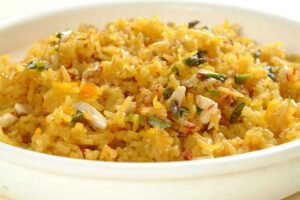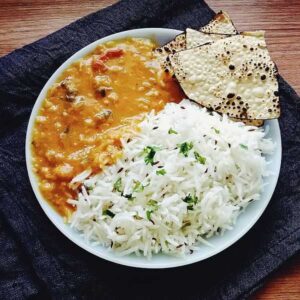Exploring the Culinary Delights of Haryana: Where Culture Meets Cuisine
When it comes to the diverse tapestry of Indian cuisine, the northern state of Haryana stands out for its unique and flavorsome offerings. With a rich cultural heritage that spans centuries, the food of Haryana reflects the region’s history, lifestyle, and agricultural abundance. Let’s embark on a gastronomic journey through the heart of India and discover the captivating flavors of Haryana.
- Cultural Melting Pot:
Haryana’s cuisine is a blend of influences from various cultures, including the Vedic, Mughal, and Rajput traditions. This amalgamation is reflected in the ingredients, cooking techniques, and flavors of its dishes. The cuisine is primarily vegetarian, with a strong emphasis on using locally grown ingredients like wheat, millets, pulses, and dairy products.
- Roti, Ghee, and More:
Wheat-based dishes are the staple of Haryanvi cuisine. The most iconic item is “Bajra Roti,” made from pearl millet, which is enjoyed with dollops of homemade ghee. The rotis are often paired with “Lassi,” a traditional yogurt-based drink that helps combat the state’s scorching summers.
- Flavorful Sabzis:
Haryana’s vegetable dishes are packed with flavors and nutrition. The use of ingredients like fenugreek leaves (“methi”), mustard greens (“sarson ka saag”), and spinach (“palak”) showcases the local produce. These greens are often combined with a hint of spices to create lip-smacking sabzis that are both wholesome and delicious.
- Pulse Power:
Pulses hold a special place in Haryanvi cuisine. Dishes like “Hara Chana,” made from green chickpeas, and “Kala Chana,” prepared from black chickpeas, are popular choices. These protein-rich dishes are typically enjoyed with rotis or rice.
- Unique Pickles and Chutneys:
Haryana’s pickles and chutneys add a burst of flavor to the meals. “Aloo Bhujiya,” a spicy potato pickle, and “Tamatar Ki Chutney,” a tangy tomato chutney, are commonly served. These condiments elevate the dining experience by introducing a range of tastes and textures.
- Sweet Indulgences:
No culinary journey is complete without indulging in sweets. “Mithe Chawal,” sweetened rice, is a beloved dessert in Haryana. Prepared with jaggery, saffron, and dry fruits, it offers a delightful contrast to the savory main courses.
- Festive Feasts:
Festivals and celebrations bring out the best of Haryanvi cuisine. During festivals like Baisakhi and Teej, special dishes like “Meethe Chawal,” “Puri,” and “Kheer” are prepared to commemorate the occasion. These dishes offer a glimpse into the cultural significance of food in Haryana.
- The Influence of Dairy:
Dairy products are integral to Haryanvi cuisine. From fresh yogurt to creamy buttermilk (“Chaach”), dairy forms an essential part of daily meals. Dairy is not only a source of nourishment but also lends a unique richness to the dishes.
- Hearty Snacks:
Haryana’s cuisine also boasts a variety of snacks that are perfect for satisfying midday cravings or enjoying as accompaniments to tea. One such popular snack is “Besan Masala Roti,” a flavorful and crispy flatbread made from chickpea flour. Another favorite is “Kachri Ki Sabzi,” a tangy and spicy dish prepared from wild melon known as “Kachri.” These snacks are not only delicious but also showcase the resourcefulness of Haryanvi cooking.
- Influences of Rural Lifestyle:
The cuisine of Haryana is deeply rooted in the rural lifestyle of the region. Many dishes have evolved from the need to create nutritious and filling meals for hardworking farmers. “Kichri” is a prime example – a simple yet nourishing dish made from rice and lentils, often served with yogurt or ghee.
- Seasonal Delicacies:
Haryana’s cuisine revolves around the availability of seasonal ingredients. For instance, during the winter months, “Bathua” (chenopodium) leaves are used to prepare flavorful dishes like “Bathua Raita.” This adaptability to seasons not only adds diversity to the menu but also ensures that meals are fresh and nutritious.
- Culinary Traditions and Rituals:
Food plays a significant role in Haryana’s cultural traditions and rituals. During weddings and other important ceremonies, elaborate feasts are prepared, showcasing a wide array of dishes that represent the state’s culinary richness. The act of sharing food is deeply ingrained in Haryanvi culture, fostering a sense of community and togetherness.
- Preservation Techniques:
To make the most of their agricultural bounty, the people of Haryana have developed various preservation techniques. “Hari Mirch ka Achar,” a spicy green chili pickle, and “Murabba,” a sweet fruit preserve, are examples of such techniques. These preserved foods not only add flavor to meals but also extend the enjoyment of seasonal produce.
- Street Food Charms:
Haryana’s street food scene offers a delightful exploration of its cuisine. From “Bhutte ka Kees,” a grated corn dish cooked with spices, to “Chana Chaat,” a tangy chickpea salad, the street vendors of Haryana add their own creative twists to traditional dishes, making them accessible and convenient for locals and tourists alike.
- Culinary Revival:
In recent years, there has been a renewed interest in Haryanvi cuisine, with efforts to preserve and promote traditional dishes. Culinary festivals, workshops, and food tours have contributed to the revival of authentic Haryana food, ensuring that these age-old recipes continue to be enjoyed by future generations.
- Local Ingredients, Global Appeal:
Haryana’s cuisine not only resonates with locals but also has the potential to captivate international palates. The simplicity and use of fresh, locally sourced ingredients align with modern culinary trends that emphasize sustainability and authenticity. Dishes like “Bajra Roti” and “Sarson ka Saag” showcase how traditional ingredients can create a powerful cu
Roti” and “Sarson ka Saag” showcase how traditional ingredients can create a powerful cu
linary experience with global appeal.
